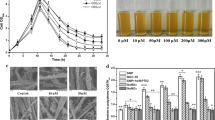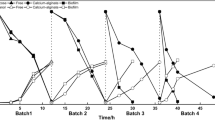Abstract
Biofilms are a form of microbial community that can be beneficial for industrial fermentation because of their remarkable environmental resistance. However, the mechanism of biofilm formation in Saccharomyces cerevisiae remains to be fully explored, and this may enable improved industrial applications for this organism. Although quorum-sensing (QS) molecules are known to be involved in bacteria biofilm formation, few studies have been undertaken with these in fungi. 2-phenylethanol (2-PE) is considered a QS molecule in S. cerevisiae. Here, we found that exogenous 2-PE could stimulate biofilm formation at low cell concentrations. ARO8p and ARO9p are responsible for the synthesis of 2-PE and were crucial to the formation of biofilm. Deletion of the ARO8 and ARO9 genes reduced the content of 2-PE in the early stage of fermentation, reduced ethanol yield and decreased biofilm formation. The expression of FLOp, which is involved in cell adhesion, and the content of extracellular polysaccharides of mutant strains ΔARO8 and ΔARO9 were also significantly reduced. These findings indicate that the production of 2-PE had a positive effect on biofilm formation in S. cerevisiae, thereby providing further key details for studying the formation of biofilm mechanism in the future.
Key points
• Quorum-sensing molecule 2-PE positively affects biofilm formation in S. cerevisiae.
• 2-PE synthetic genes ARO8 and ARO9 deletion reduced extracellular polysaccharide.
• ARO8 and ARO9 deletion reduced the gene expression of the FLO family.









Similar content being viewed by others
Availability of data
The authors promise the availability of supporting data.
References
Alem MA, Oteef MD, Flowers TH, Douglas LJ (2006) Production of tyrosol by Candida albicans biofilms and its role in quorum sensing and biofilm development. Eukaryot Cell 5(10):1770–1779
Al-Wrafy F, Brzozowska E, Gorska S, Gamian A (2017) Pathogenic factors of Pseudomonas aeruginosa - the role of biofilm in pathogenicity and as a target for phage therapy. Postep Hig Med Dosw 71(71):78–91
Avbelj M, Zupan J, Kranjc L, Raspor P (2015) Quorum-sensing kinetics in Saccharomyces cerevisiae: a symphony of ARO genes and aromatic alcohols. J Agric Food Chem 63(38):8544–8550
Blankenship JR, Mitchell AP (2006) How to build a biofilm: a fungal perspective. Curr Opin Microbiol 9(6):588–594
Cao YY, Cao YB, Xu Z, Ying K, Li Y, Xie Y, Zhu ZY, Chen WS, Jiang Y (2005) cDNA microarray analysis of differential gene expression in Candida albicans biofilm exposed to farnesol. Antimicrob Agents Chemother 49(2):584–589
Chen H, Fink GR (2006) Feedback control of morphogenesis in fungi by aromatic alcohols. Genes Dev 20(9):1150–1161
Chen Y, Liu Q, Zhou T, Li B, Yao S, Li A, Wu J, Ying H (2013) Ethanol production by repeated batch and continuous fermentations by Saccharomyces cerevisiae immobilized in a fibrous bed bioreactor. J Microbiol Biotechnol 23(4):511–517
Chen T, Liu N, Ren P, Xi X, Yang L, Sun W, Yu B, Ying H, Ouyang P, Liu D (2019) Efficient biofilm-based fermentation strategies for l-threonine production by Escherichia coli. Front Microbiol 10:1773
Davies DG, Parsek MR, Pearson JP, Iglewski BH, Costerton JW, Greenberg EP (1998) The involvement of cell-to-cell signals in the development of a bacterial biofilm. Science 280(5361):295–298
Donlan RM (2001) Biofilm formation: a clinically relevant microbiological process. Clin Infect Dis 33(8):1387–1392
Ehrlich GD, Stoodley P, Kathju S, Zhao Y, Mcleod BR, Balaban N, Hu FZ, Sotereanos NG, Costerton JW, Stewart PS, Post JC, Lin Q (2005) Engineering approaches for the detection and control of orthopaedic biofilm infections. Clin Orthop Relat Res 437:59–66
Guo B, Styles CA, Feng Q, Fink GR (2000) A Saccharomyces gene family involved in invasive growth, cell–cell adhesion, and mating. Proc Natl Acad Sci U S A 97(22):12158–12163
Hooshangi S, Bentley WE (2008) From unicellular properties to multicellular behavior: bacteria quorum sensing circuitry and applications. Curr Opin Biotechnol 19(6):550–555
Hornby JM, Jensen EC, Lisec AD, Tasto JJ, Jahnke B, Shoemaker R, Dussault P, Nickerson KW (2001) Quorum sensing in the dimorphic fungus Candida albicans is mediated by farnesol. Appl Environ Microbiol 67(7):2982–2992
Joseph R, Naugolny A, Feldman M, Herzog IM, Fridman M, Cohen Y (2016) Cationic pillararenes potently inhibit biofilm formation without affecting bacterial growth and viability. J Am Chem Soc 138(3):754–757
Kuhn D, George T, Chandra J, Mukherjee PK, Ghannoum MA (2002) Antifungal susceptibility of Candida biofilms: unique efficacy of amphotericin B lipid formulations and echinocandins. Antimicrob Agents Chemother 46(6):1773–1780
Lenhart BA, Meeks B, Murphy HA (2019) Variation in filamentous growth and response to quorum-sensing compounds in environmental isolates of Saccharomyces cerevisiae. G3-Genes Genomes Genet 9(5):1533–1544
Li Z, Chen Y, Liu D, Zhao N, Cheng H, Ren H, Guo T, Niu H, Zhuang W, Wu J, Ying H (2015) Involvement of glycolysis/gluconeogenesis and signaling regulatory pathways in Saccharomyces cerevisiae biofilms during fermentation. Front Microbiol 6:139
Liang C, Ding S, Sun W, Liu L, Zhao W, Zhang D, Ying H, Liu D, Chen Y (2020) Biofilm-based fermentation: a novel immobilisation strategy for Saccharomyces cerevisiae cell cycle progression during ethanol production. Appl Microbiol Biotechnol 104(17):7495–7505
Liu D, Chen Y, Li A, Ding F, Zhou T, He Y, Li B, Niu H, Lin X, Xie J, Chen X, Wu J, Ying H (2013) Enhanced butanol production by modulation of electron flow in Clostridium acetobutylicum B3 immobilized by surface adsorption. Bioresour Technol 129:321–328
Liu S, Gunawan C, Barraud N, Rice SA, Harry EJ, Amal R (2016) Understanding, monitoring, and controlling biofilm growth in drinking water distribution systems. Environ Sci Technol 50(17):8954–8976
Liu L, Yu B, Sun W, Liang C, Ying H, Zhou S, Niu H, Wang Y, Liu D, Chen Y (2020) Calcineurin signaling pathway influences Aspergillus niger biofilm formation by affecting hydrophobicity and cell wall integrity. Biotechnol Biofuels 13(1):1–13
Martins M, Henriques M, Azeredo J, Rocha SM, Coimbra MA, Oliveira R (2007) Morphogenesis control in Candida albicans and Candida dubliniensis through signaling molecules produced by planktonic and biofilm cells. Eukaryot Cell 6(12):2429–2436
Miller MB, Bassler BL (2001) Quorum sensing in bacteria. Annu Rev Microbiol 55(1):165–199
Padder SA, Prasad R, Shah AH (2018) Quorum sensing: a less known mode of communication among fungi. Microbiol Res 210:51–58
Pan Y, Breidt F, Gorski L (2010) Synergistic effects of sodium chloride, glucose, and temperature on biofilm formation by Listeria monocytogenes serotype 1/2a and 4b strains. Appl Environ Microbiol 76(5):1433–1441
Parsek MR, Greenberg EP (2005) Sociomicrobiology: the connections between quorum sensing and biofilms. Trends Microbiol 13(1):27–33
Ryan OW, Poddar S, Cate JH (2016) CRISPR–Cas9 genome engineering in Saccharomyces cerevisiae cells. Cold Spring Harb Protoc. https://doi.org/10.1101/pdb.prot086827
Shi X, Chen Y, Ren H, Liu D, Zhao T, Zhao N, Ying H (2014) Economically enhanced succinic acid fermentation from cassava bagasse hydrolysate using Corynebacterium glutamicum immobilized in porous polyurethane filler. Bioresour Technol 174:190–197
Silvers TR, Myers JK (2013) Osmolyte effects on the self-association of concanavalin a: testing theoretical models[J]. Biochemistry 52(51):9367–9374
Suresh Kumar A, Mody K, Jha B (2007) Bacterial exopolysaccharides—a perception. J Basic Microbiol 47(2):103–117
Tarkka MT, Sarniguet A, Frey-Klett P (2009) Inter-kingdom encounters: recent advances in molecular bacterium–fungus interactions. Curr Genet 55(3):233–243
Verstrepen KJ, Klis FM (2006) Flocculation, adhesion and biofilm formation in yeasts. Mol Microbiol 60(1):5–15
Wang Z, Bai X, Guo X, He X, Biotechnology (2017) Regulation of crucial enzymes and transcription factors on 2-phenylethanol biosynthesis via Ehrlich pathway in Saccharomyces cerevisiae. J Ind Microbiol Biotechnol 44(1):129–139
Yan W, Zhang X, Qian X, Zhou J, Dong W, Ma J, Zhang W, Xin F, Jiang M (2020) Comprehensive investigations of 2-phenylethanol production by high 2-phenylethanol tolerating Meyerozyma sp. strain YLG18. Enzym Microb Technol 140:109629
Yang Q, Defoirdt T (2015) Quorum sensing positively regulates flagellar motility in pathogenic Vibrio harveyi. Environ Microbiol 17(4):960–968
Yang L, Zheng C, Chen Y, Ying H (2018) FLO genes family and transcription factor MIG1 regulate Saccharomyces cerevisiae biofilm formation during immobilized fermentation. Front Microbiol 9:1860
Yang L, Zheng C, Chen Y, Shi X, Ying Z, Ying H (2019) Nitric oxide increases biofilm formation in Saccharomyces cerevisiae by activating the transcriptional factor Mac1p and thereby regulating the transmembrane protein Ctr1. Biotechnol Biofuels 12(1):30
Zhao N, Ren H, Li Z, Zhao T, Shi X, Cheng H, Zhuang W, Chen Y, Ying H (2015) Enhancement of nuclease P1 production by Penicillium citrinum YL104 immobilized on activated carbon filter sponge. Appl Microbiol Biotechnol 99(3):1145–1153
Funding
This work was supported by the National Key Research and Development Program of China (Grant No. 2018YFA0902200, 2018yfb1501705), the key program of the National Natural Science Foundation of China (Grant No. 21636003), the Outstanding Youth Foundation of China (Grant No. SBK2017010373), the Program for Changjiang Scholars and Innovative Research Team in University (IRT_14R28), Jiangsu National Synergetic Innovation Center for Advanced Materials (SICAM), the Technology Support Program of Jiangsu (Grant No. BE2014715) and the Priority Academic Program Development of Jiangsu Higher Education Institutions (PAPD).
Author information
Authors and Affiliations
Contributions
DZ participated in the design of the study, constructed the plasmids and strains, participated in the fermentation experiments, drafted the manuscript and revised the manuscript. FW, YY, SD, TC, WS, CL and BY participated in the fermentation experiments and biofilm characterization experiment. YC, HY and DL participated in the design of the study. HY conceived of the study and participated in its design. All authors read and approved the final manuscript.
Corresponding authors
Ethics declarations
Ethics approval and consent to participate
Not applicable.
Consent for publication
Publication consented.
Competing interests
The authors declare no competing interests.
Additional information
Publisher’s note
Springer Nature remains neutral with regard to jurisdictional claims in published maps and institutional affiliations.
Rights and permissions
About this article
Cite this article
Zhang, D., Wang, F., Yu, Y. et al. Effect of quorum-sensing molecule 2-phenylethanol and ARO genes on Saccharomyces cerevisiae biofilm. Appl Microbiol Biotechnol 105, 3635–3648 (2021). https://doi.org/10.1007/s00253-021-11280-4
Received:
Revised:
Accepted:
Published:
Issue Date:
DOI: https://doi.org/10.1007/s00253-021-11280-4




